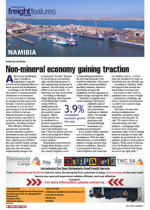The Walvis Bay Corridor Group (WBCG) is actively engaging with developers on a major new trade route that will link Kolwezi in the Democratic Republic of Congo (DRC) to Walvis Bay in Namibia, bypassing the heavily congested Copperbelt region and the overburdened Kasumbalesa border post.According to Mbahupu Hippy Tjivikua, CEO of the WBCG, the new route will run from Kolwezi down to Solwezi, across to Mongu, through Katima Mulilo, and onward to Walvis Bay. Developers have already signed a concession agreement and are preparing to build new roads and a new border post between the DRC and Zambia, eliminating the need for cargo to pass through Kasumbalesa.Notably, the new corridor will be 235km shorter than the current Walvis Bay-Ndola-Lubumbashi corridor and up to seven days faster.This comes on the back of new and existing copper developments in the DRC and Zambia, where output is expected to increase significantly over the next few years. The DRC last year officially became the world’s second-largest producer of copper, with production nearing three million tons per year. Zambia has announced its intention to gear up production to over one million tons annually.“The development of this corridor is extremely important for the region, particularly if one considers that Zambia and the DRC have plans to reach targets of six million tons of copper per year,” said Tjivikua. “It avoids the congested Kitwe–Copperbelt–Lusaka route and offers a direct connection for copper exports.”He said some portions of the road were in good condition, but there were areas where major upgrades would have to be done. He added that a new border post would also relieve some of the pressure on the existing posts.The queue at the Sakanya border post, which connects Zambia and the DRC, has at times stretched all the way to Ndola, with up to 600 trucks a day facing delays of up to 20 days in each direction. While diverting traffic to Sakanya has eased congestion at Kasumbalesa, it has merely shifted the bottleneck rather than resolved it. A new corridor offers a fundamentally different solution – one that addresses the root of the problem rather than displacing it.Tjivikua used the Kazungula Bridge and border post as examples of modern border infrastructure and the significant impact such facilities have on improving efficiency. “Kazungula is a brilliant facility that addresses modern challenges. We should look at replicating that model and updating border systems so cargo can f low efficiently,” he said. LV

